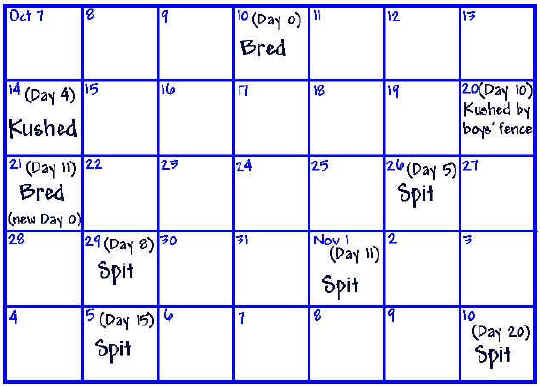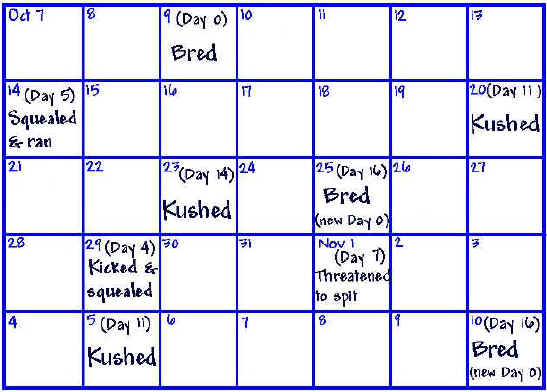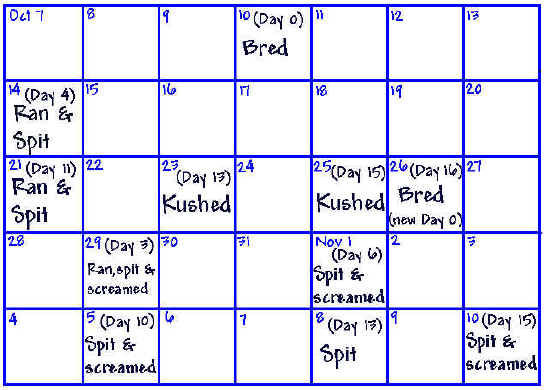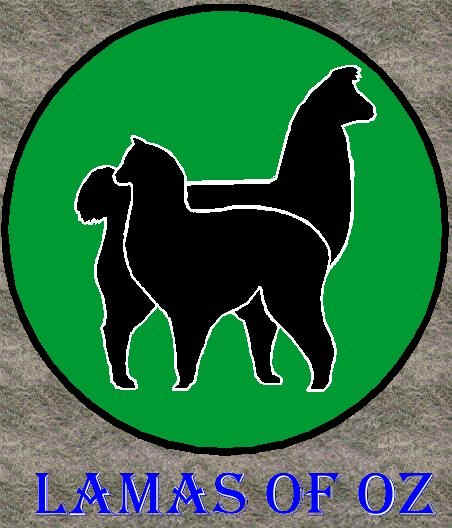BREEDING/OVULATION CHARTS
Below are charts I developed for determining best rebreeding days after an initial unsuccessful breeding. The first chart is the possible combinations of repeating pattern of ripe follicle days (+) followed by days with no ripe follicle (-) that I used to count likelihood of ovulation if bred on a certain day. The second chart is used if the breeding did not trigger ovulation. The third determines best days to rebreed if the first breeding caused the female to ovulate but did not result in pregnancy.
Summary:
If ovulation occurred, chances of hitting a ripe follicle day, if you rebreed at:
16 days: 73%
14, 15, 17 or 18 days: 70%
21 days: 66.7%
13, 19, 20 or 22 days: 63.3%
11 or 12 days: 60%
If ovulation did not occur, chances of hitting a ripe follicle day if you rebreed at:
3 or 4 days: 100% (Not recommended due to chance of infection & damage done during breeding)
11 days: 86.7%
10 or 12 days: 80%
13 days: 73.3%
15 days: 66.7%
17 days: 60%
9, 14 or 16 days: 53.3%
7 days: 46.7%
8 days: 33.3%
Assumptions:
The female has a ripe follicle for 4-6 days, then no ripe follicle for 2-3 days (according to "Llama and Alpaca Neonatal Care" by Smith, Timm & Long). These charts are also based on the assumption that the female did not ovulate DUE to the fact that she did not have a ripe follicle at the time of breeding (this won't always be the case).
Recommendation:
Rebreed 11 days after the initial breeding if the female did not ovulate; rebreed 16 days after the initial breeding if she did ovulate.
Explanation:
I used every possible combination of 4-6 days (ripe follicle)(+) and 2-3 days (no ripe follicle)(-). ie. 4 days (+) and 2 days (-) would be ++++--++++-- in a repeating pattern. 6 days (+) and 3 days (-) would be ++++++---++++++---. By checking with the male we determined if the female ovulated or not. If she didn't ovulate, I started counting days (eg. 7 days = breeding 7 days later) on one of the minus signs (-) to see which day I ended up on. I did that for each minus sign. ie. the 4/2 combination would have 2 possible outcomes (for 7 days, I get one - and one + for the 4/2 combo). I then repeated for each possible combination of +/- days, ie. 4/2, 4/3, 5/2, 5/3, 6/2, 6/3. Then I repeated the whole thing for each # of days after the initial breeding I wanted to figure into my chart (7-17 days). If she did ovulate, I started counting on the plus signs (+). For the 4/2 combination there are 4 possible outcomes. And go through the above for all the possibilities. I started with 11 days since this is when we've found the girls to show receptivity. When I had all the data I averaged it all to get the percentages of hitting a (+) or ripe follicle day by breeding so many days after the initial breeding, if she ovulated or if she didn't.
Chart 1 - Day Counter
| 4/2 | + | + | + | + | - | - | + | + | + | + | - | - | ||||||
| 4/3 | + | + | + | + | - | - | - | + | + | + | + | - | - | - | ||||
| 5/2 | + | + | + | + | + | - | - | + | + | + | + | + | - | - | ||||
| 5/3 | + | + | + | + | + | - | - | - | + | + | + | + | + | - | - | - | ||
| 6/2 | + | + | + | + | + | + | - | - | + | + | + | + | + | + | - | - | ||
| 6/3 | + | + | + | + | + | + | - | - | - | + | + | + | + | + | + | - | - | - |
Chart 2 - Best Rebreeding Days If Ovulation Did Not Occur
| RIPE/ NON- RIPE | 3/4 DAYS | 7 DAYS | 8 DAYS | 9 DAYS | 10 DAYS | 11 DAYS | 12 DAYS | 13 DAYS | 14 DAYS | 15 DAYS | 16 DAYS | 17 DAYS |
| DAYS | + | - | + | - | + | - | + | - | + | - | + | - | + | - | + | - | + | - | + | - | + | - | + | - |
| 4/2 | 2 | 0 | 1 | 1 | 2 | 0 | 2 | 0 | 2 | 0 | 1 | 1 | 0 | 2 | 1 | 1 | 2 | 0 | 2 | 0 | 2 | 0 | 1 | 1 |
| 4/3 | 3 | 0 | 0 | 3 | 1 | 2 | 2 | 1 | 3 | 0 | 3 | 0 | 2 | 1 | 1 | 2 | 0 | 3 | 1 | 2 | 2 | 1 | 3 | 0 |
| 5/2 | 2 | 0 | 0 | 2 | 1 | 1 | 2 | 0 | 2 | 0 | 2 | 0 | 2 | 0 | 1 | 1 | 0 | 2 | 1 | 1 | 2 | 0 | 2 | 0 |
| 5/3 | 3 | 0 | 3 | 0 | 0 | 3 | 1 | 2 | 2 | 1 | 3 | 0 | 3 | 0 | 3 | 0 | 1 | 2 | 2 | 1 | 0 | 3 | 1 | 2 |
| 6/2 | 2 | 0 | 1 | 1 | 0 | 2 | 1 | 1 | 2 | 0 | 2 | 0 | 2 | 0 | 2 | 0 | 2 | 0 | 1 | 1 | 0 | 2 | 1 | 1 |
| 6/3 | 3 | 0 | 2 | 1 | 1 | 2 | 0 | 3 | 1 | 2 | 2 | 1 | 3 | 0 | 3 | 0 | 3 | 0 | 3 | 0 | 2 | 1 | 1 | 2 |
| TOTALS | 15 | 0 | 7 | 8 | 5 | 10 | 8 | 7 | 12 | 3 | 13 | 2 | 12 | 3 | 11 | 4 | 8 | 7 | 10 | 5 | 8 | 7 | 9 | 6 |
| % CHANCE OF RIPE (+) | 100 | 46.7 | 33.3 | 53.3 | 80 | 86.7 | 80 | 73.3 | 53.3 | 66.7 | 53.3 | 60 |
Chart 3 - Best Rebreeding Days if Ovulation Occurred But Pregnancy Did Not
| RIPE/ NON- RIPE | 11 DAYS | 12 DAYS | 13 DAYS | 14 DAYS | 15 DAYS | 16 DAYS | 17 DAYS | 18 DAYS | 19 DAYS | 20 DAYS | 21 DAYS | 22 DAYS |
| DAYS | + | - | + | - | + | - | + | - | + | - | + | - | + | - | + | - | + | - | + | - | + | - | + | - |
| 4/2 | 3 | 1 | 4 | 0 | 3 | 1 | 2 | 2 | 2 | 2 | 2 | 2 | 3 | 1 | 4 | 0 | 3 | 1 | 2 | 2 | 2 | 2 | 2 | 2 |
| 4/3 | 2 | 2 | 2 | 2 | 3 | 1 | 4 | 0 | 3 | 1 | 2 | 2 | 1 | 3 | 1 | 3 | 2 | 2 | 3 | 1 | 4 | 0 | 3 | 1 |
| 5/2 | 3 | 2 | 3 | 2 | 4 | 1 | 5 | 0 | 4 | 1 | 3 | 2 | 3 | 2 | 3 | 2 | 3 | 2 | 4 | 1 | 5 | 0 | 4 | 1 |
| 5/3 | 2 | 3 | 2 | 3 | 2 | 3 | 3 | 2 | 4 | 1 | 5 | 0 | 4 | 1 | 3 | 2 | 2 | 3 | 2 | 3 | 2 | 3 | 3 | 2 |
| 6/2 | 4 | 2 | 4 | 2 | 4 | 2 | 4 | 2 | 5 | 1 | 6 | 0 | 5 | 1 | 4 | 2 | 4 | 2 | 4 | 2 | 4 | 2 | 4 | 2 |
| 6/3 | 4 | 2 | 3 | 3 | 3 | 3 | 3 | 3 | 3 | 3 | 4 | 2 | 5 | 1 | 6 | 0 | 5 | 1 | 4 | 2 | 3 | 3 | 3 | 3 |
| TOTALS | 18 | 12 | 18 | 12 | 19 | 11 | 21 | 9 | 21 | 9 | 22 | 8 | 21 | 9 | 21 | 9 | 19 | 11 | 19 | 11 | 20 | 10 | 19 | 11 |
| % CHANCE OF RIPE (+) | 60 | 60 | 63.3 | 70 | 70 | 73.3 | 70 | 70 | 63.3 | 63.3 | 66.7 | 63.3 |
Results:
Female A: Bred Oct 10/01 (Day 0). Did not ovulate (she was receptive to the male). Rebred 11 days later (new Day 0). Determined that she did ovulate (spitting at male on 5th, 8th, 11th & 15th days). Spit on 20th day - probably pregnant.

Female B: Bred on Oct 9/01 (Day 0). Ovulated (5 days later she squealed & ran from the male). Kushed for the male on the 11th day after breeding. Rebred on the 16th day (new Day 0). Ovulated (4th day - kicked male & squealed; 7th day - threatened to spit at male). 11th day - kushed. Rebred on the 16th day.

Female C: Bred on Oct 10/01 (Day 0). Ovulated (spit at male on 4th & 11th days). 13th day - somewhat receptive. 15th day - very receptive. Rebred on 16th day (new Day 0). Ovulated (spit at male on 3rd, 6th & 13th days). 15th day - spit & screamed - probably pregnant.

I hope these odds work for you. Please email us to let us know at lamasofoz@yahoo.ca Happy breeding! Jennifer
Charts and information not to be reproduced other than for personal use. Copyright 2001
